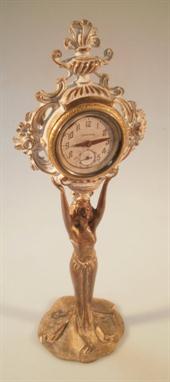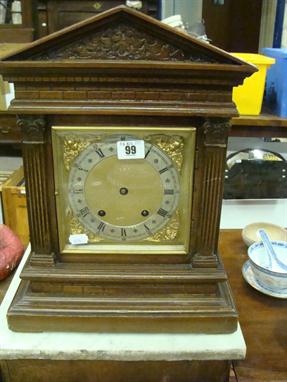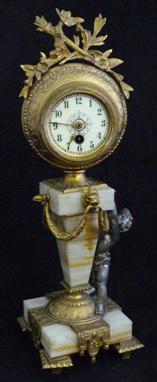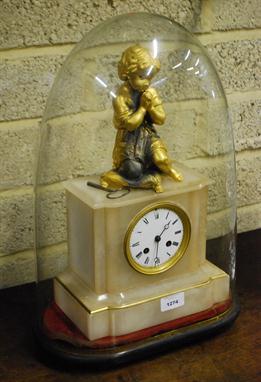We found 96232 price guide item(s) matching your search
There are 96232 lots that match your search criteria. Subscribe now to get instant access to the full price guide service.
Click here to subscribe- List
- Grid
-
96232 item(s)/page
A 19th century gilt metal and porcelain striking mantel clock, the circular hand painted Roman numeral dial marked Row & Son, Paris (dial af), with ornate drum housed movement and twin handle urn form finial, complete with pendulum, and stepped detached plinth base, height not including plinth 31cm
A 19th century French Alabaster and gilt metal eight day striking mantel clock of stepped architectural form with mask head base and scrolled ends, complete with pendulum, raised on four brass feet, also a pair of 19th century carved Alabaster ewers with phoenix handles (both af, 3), height of clock 29.5cm, height of ewers 39.5cm
A 19th century French Champlevé enamel brass and onyx serpentine fronted striking mantel clock, with bevelled glass central housing flanked by four bulbous tapering columns, the circular brass dial with enamelled outer and central ring with Arabic numeral roundels stamped 'Marque Depose', with ornate internal base enamelled section, on four bulbous feet, with twin handled urn and four corner finial's, complete with mercury pendulum and key, with bell striking movement, height 45.5cm (illustrated)
A 17th century shield carved with an oak tree, 16 by 13cm, a glass measure in a treen box, an oak barometer, 65cm, a Wedgwood black basalt pot, a loving spoon, a crumb tray, an Edwardian mantel clock with Gothic arch, a Chinese carved wooden dish, 30cm diameter, a tray, and a carved wooden fragment. (10)
A 19th century perpetual calendar mantel clock the eight-day duration movement striking the hours and half-hours on a bell, stamped on the backplate ‘J.B.D’, with a visible Brocot escapement to the centre of the two-piece enamel dial, with black Roman numerals, a sweep seconds hand and blued steel moon hands, with a glazed panel below the dial through which is visible the Ellicott style compensating pendulum, with two thermometers set either side of the dial, each with white enamel dials and both signed ‘Paris 1838’, the left-hand side dial showing Reaumur, the right-hand side showing Fahrenheit, with a round barometer dial set to the lower right-hand side having two badges stamped on, one reading ‘E. Bourdon and Richards, Patent, Gold Medal, Paris Exhibition’, the other ‘Council Medal, Universal Exhibition, London, 1851’, and numbered ‘21849’ with a further dial to the left-hand lower having three subsidiary dials showing the moonphase, day and date, with the outer dial marked for the perpetual calendar changes and the month, the black and red marble case of Egyptian influence with pyramid style sides, height 45cms.
A Sitzendorf porcelain monkey band mantel clock the eight-day duration movement striking the hours and half-hours on a bell, the backplate stamped with the trademark for Japy Freres, the white enamel dial with black Roman numerals and blued steel spade hands, the case in the form of floral decoration surrounding a Monkey band, height 33cm. * For details of Japy Freres see lot no. 642.
tupman, London, an ormolu mantel clock the eight-day duration timepiece fusee movement, signed to the backplate ‘Baetens, London’, the white enamel dial with black Roman numerals, blued steel moon hands, and signed with the retailer’s name ‘Tupman, 44 Gt Russell, St’, the ormolu case with a classical winged female figure holding a cornucopia of flowers and leaning against the central block with raised decorative mounts, with a pillar to the other side having a nautical theme, the base with applied mounts and standing on turned feet, height: 34cm. * Various members of the Tupman family are recorded working in the early 19th century including William Tupman, apprenticed in 1806, the son of the clockmaker George, who was working from circa 1794, with the partnership of George & Henry recorded from circa 1844. They were both clockmakers and retailers. * Joseph Baetens is recorded as working in London circa 1832 specialising in bronze and ormolu clocks.
A chiming oak mantel clock the eight-day duration movement chiming the quarters on four gongs and the hour on a further gong, the brass break-arch dial having black Roman numerals, c-scroll spandrels, blued steel hands and a roundel to the arch engraved ‘Tempus Fugit’, the oak break-arch case having barley-twist columns, height 39cm.
-
96232 item(s)/page















































